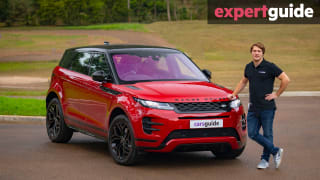
Range Rover Evoque 2019 review
The new Evoque has some big shoes to fill, and has moved up a size in order to do it. Has it lost anything along the way? We drive it at its long-awaited launch to find out.
Browse over 9,000 car reviews

For years, if you wanted a sleek British SUV, you had the simple choice of one car; the Range Rover Evoque. It's a lovely car and all (and it just clicked over to its second-generation), but if you weren't keen on any of the growing number of Germans and didn't want that particular Rangie, you were stuck.
Jaguar was stuck, too. With a sister brand built on SUVs before they were even called that, it seemed a no-go area for Jag, and it wasn't until the F-Pace that the leaping cat could even start to make inroads into a market that had developed a deep love of cars on stilts.
Eighteen months ago, the E-Pace finally met the road. Built on the wildly successful Evoque platform, sleek and small(er) had finally arrived in the Jaguar range, giving buyers a second, very British choice.
But it's a choice that has yet to charm too many people and we wanted to find out why, or why not.
Our car had optional 20-inch wheels wrapped in Pirelli P-Zeros, as well as the Performance Pack, which adds bigger brakes with red brake calipers.
| Jaguar E-Pace 2019: D180 R-Dynamic SE AWD (132KW) | |
|---|---|
| Safety rating | |
| Engine Type | 2.0L turbo |
| Fuel Type | Diesel |
| Fuel Efficiency | 6L/100km |
| Seating | 5 seats |
| Price from | $51,920 |
The E-Pace is a victim of Jaguar's wildly complicated range structure, something the company has promised to address after its new local MD understandably asked why on Earth we need a gazillion different options.
You can choose from up to six engine options and four trim levels, along with the addition of the R Dynamic styling pack. My Jag for the week was an E-Pace D180 SE R-Dynamic, which starts at $65,590.
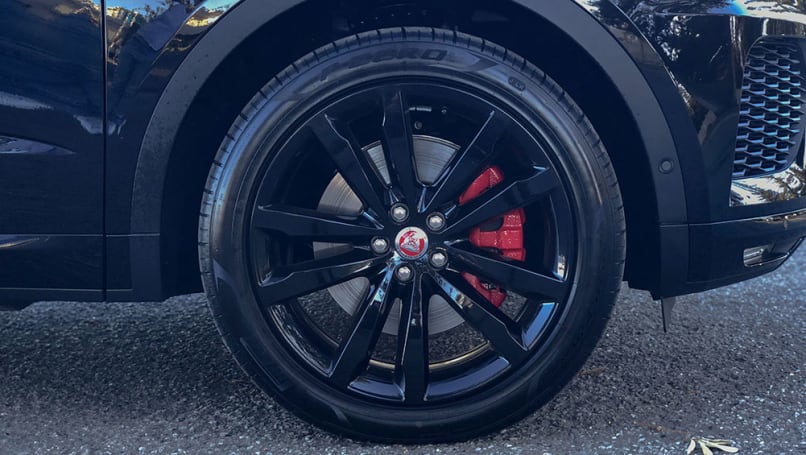
For that you get an 11-speaker stereo, 19-inch alloys, dual-zone climate control, reversing camera, keyless entry, front, rear and side parking sensors, cruise control, electric front seats, sat nav, LED headlights, leather seats, auto parking, electric tailgate, power everything, auto headlights and wipers and a space-saver spare.
The Meridian-branded stereo is powered by Jaguar-Land Rover's 10.0-inch TouchPro. It's a pretty good system in 2019, after a ropey start a few years back. The sat nav input is still a pain in the fingers (not literally, it's just slow), but it's clear, easy to use and includes Apple CarPlay and Android Auto.
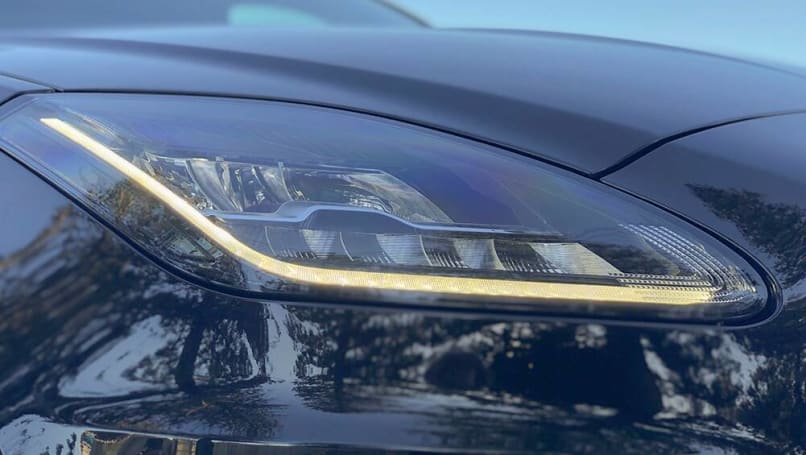
Jaguar calls the smaller-than-F-Pace vehicle "the cub". Because it's a baby Jaguar. Get it?
Interestingly, it's not just a shrunken F-Pace, owing more to the sporty F-Type when viewed from the front. The headlights are SUV-ified F-Type units, with the signature J shape. Flanking a big bold grille and placed over big brake ducts, you get the impression Jaguar was keen to emphasise the S in SUV. That theme continues in profile with a fast-looking roofline meeting a muscular rear end that looks brilliant from the rear three-quarter. I think it's better looking than the handsome F-Pace.
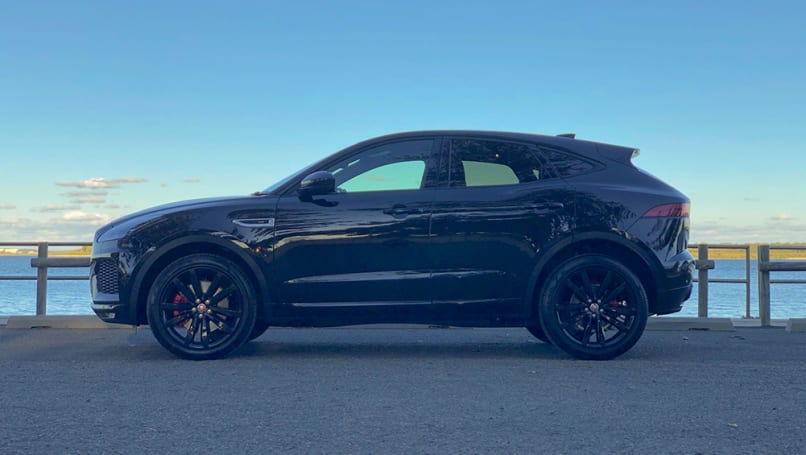
The R Dynamic Pack blacks out most of the chrome and adds black wheels
Inside is contemporary without being too exciting, although it's worth noting the F-Type influences are everywhere, including the more normal shifter as opposed to the dramatic, rising rotary dial of other Jags. Everything is clear and easy to use, although the greyness of the dash plastics might be a tad overwhelming without any splashes of wood or aluminium to break them up.
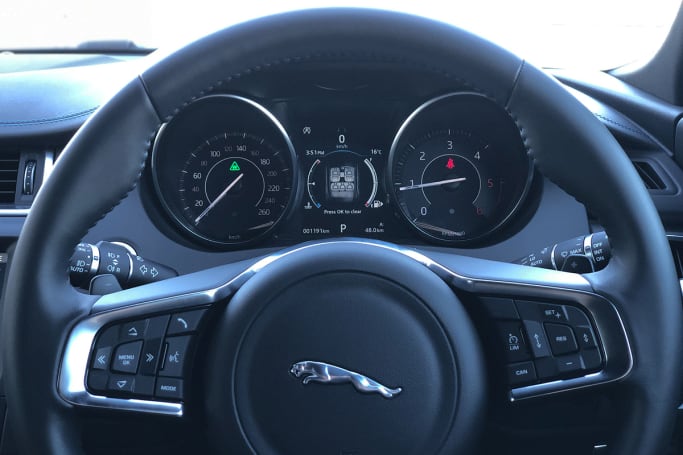
As it's based on the Evoque, it's unsurprising that the rear seats aren't exactly amazing, but they'll do the same job as, say, a Mazda CX-5. So space is solid if unspectacular, with okay legroom and headroom for people up to 185cm (yes, number-one son). The rear seats score their own air-conditioning vents and there are four USB ports and three 12V sockets for charging.
Front and rear seats each have a pair of cupholders for a total of four, while the doors will swallow a decent-sized bottle. The boot starts at 577 litres with the seats in place (my gut says that's a to-the-roof number) with that figure rising to 1234 litres when the seats are folded down. The boot is a good shape, with vertical walls on either side, free of wheel-arch intrusions.
The D180 is the second of three diesel Ingenium engines. All are of 2.0-litres in size and the D150 and D180 carry a single turbo. The D180 brings 132kW and 430Nm to the table and sends it out through a nine-speed ZF automatic.
All E-Paces available in Australia are all-wheel drive and in this guise, they'll carry you to 100km/h in over nine seconds, which isn't bad for an 1800kg car.
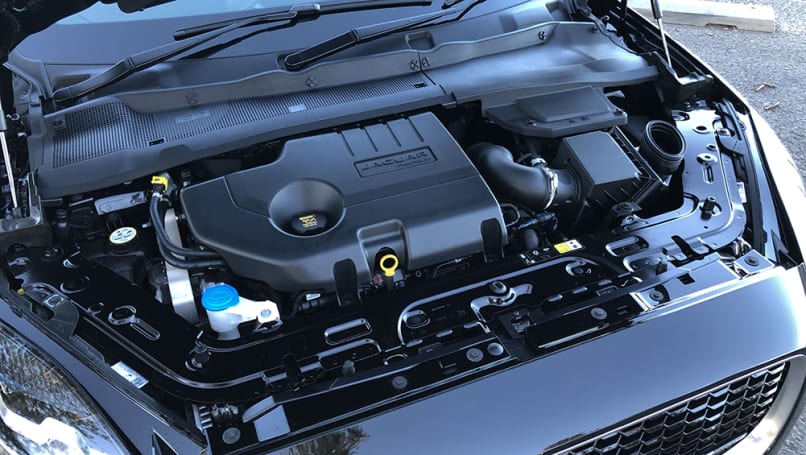
The ADR-approved fuel sticker suggests you'll get 6L/100km on the combined cycle while emitting 158g/km. A week of suburban warrioring and some modest highway driving delivered an indicated 8.0L/100km, which wasn't unexpected given the car's weight.
The E-Pace leaves Magna-Steyr's Austrian factory with six airbags (with another under the bonnet for pedestrians), reversing camera, forward AEB, traction and stability controls, brake force distribution, lane-departure warning, lane-keep assist and reverse cross-traffic alert.
That's not a bad haul for a Jaguar, even with an SE badge.
To that list you can add three top-tether points and two ISOFIX anchors.
The E-Pace scored five ANCAP stars in 2017.
Basic Warranty
3 years / 100,000 km warranty
ANCAP Safety Rating

As with the rest of the premium makers, Jaguar is sticking with three-year/100,000km warranty with roadside assist to match. Seems weird that nobody has broken for five years at this premium level yet, but it's only a matter of time before they do.
You can buy another one or two years of warranty when you buy the car.
You can also buy a service plan, which covers five years of servicing. For diesel cars, that also covers 102,000km and costs $1500 (petrols are the same price, but cover five years/130,000km). Jaguar likes to see you every 12 months or 26,000km (the petrols are an amazing 24 months/34,000km).
I've been itching to have a go in the E-Pace on Australian roads as well as being keen to drive the diesel. The only E-Pace I had driven was on Corsica's brilliantly tight and twisty roads and it was the full-fat P300. Australian roads are a completely different kettle of fish - compared with Corsica's mostly brilliantly maintained surfaces and, of course, a lower-powered diesel could well expose the chunky chassis' possible shortcomings.
As soon as I was back behind the wheel of the E-Pace, I remembered how good it was to drive. Nicely weighted steering, good vision in most directions, sensible driving position and a cosy fit. Again, it feels more like the F-Type than the F-Pace, except you won't be able to see the underside of a semi-trailer from the E-Pace.
The D180 had a bit more kick off the line than I was expecting, given its modest power figure of 132kW. It helps to have nine gears to make the most of it and, for once, the ZF nine-speed wasn't the disaster I've found it to be in a few other cars. I was cautiously optimistic about it being better in the E-Pace and a week with it proved it a step up. The Ingenium diesel is smooth and quiet and once you're up and running has a pretty decent punch for overtaking or peak-hour acrobatics.
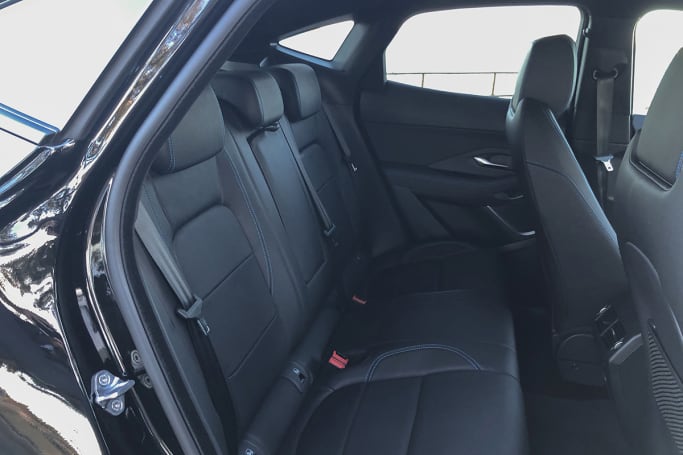
What was also nice was how well the ride has translated to Australian roads. Even on 20-inch alloys it managed the potholes and ruts of Sydney's roads really well. It's firm - don't expect pillowy ride in any Jag, really - but not crashy or messy.
Obviously, the diesel engine doesn't deliver much delight for the ears and while the nine speed is good, it's still not as good as the ZF eight speed. And of course, if you really push the E-Pace, you begin to feel the weight, but that doesn't really happen until you're giving it a walloping.
I still prefer a petrol-engined E-Pace, but if you handed me a diesel I wouldn't be upset.

The E-Pace is a fine alternative to any of its similarly-priced competitors from Britain and Germany. Nothing else looks remotely like it and few badges are as evocative as the that cat leaping across the tailgate. Jaguar is making the best cars it has ever made and the E-Pace is one of the best built, too.
It's genuinely sporty, even if not particularly quick in D180 guise. The SE specification is quite good, even if it is missing a couple of obvious things that are expensive to add (blind-spot monitoring, for instance) when you tick the box.
The only perplexing thing about the E-Pace is that I don't see them on the road more often.
| Vehicle | Specs | Price* | |
|---|---|---|---|
| D150 HSE AWD (110kW) | 2.0L, Diesel, 9 SP AUTO | $61,490 – 70,730 | 2019 Jaguar E-PACE 2019 D150 HSE AWD (110kW) Pricing and Specs |
| D150 R-Dynamic HSE AWD (110kW) | 2.0L, Diesel, 9 SP AUTO | $66,000 – 75,900 | 2019 Jaguar E-PACE 2019 D150 R-Dynamic HSE AWD (110kW) Pricing and Specs |
| P250 R-Dynamic HSE AWD (183KW) | 2.0L, PULP, 9 SP AUTO | $58,080 – 66,770 | 2019 Jaguar E-PACE 2019 P250 R-Dynamic HSE AWD (183KW) Pricing and Specs |
| D150 SE AWD (110kW) | 2.0L, Diesel, 9 SP AUTO | $56,320 – 64,680 | 2019 Jaguar E-PACE 2019 D150 SE AWD (110kW) Pricing and Specs |
| Price and features | 7 |
|---|---|
| Design | 8 |
| Practicality | 7 |
| Under the bonnet | 8 |
| Efficiency | 7 |
| Safety | 7 |
| Ownership | 7 |
| Driving | 7 |
$27,888
Lowest price, based on 18 car listings in the last 6 months